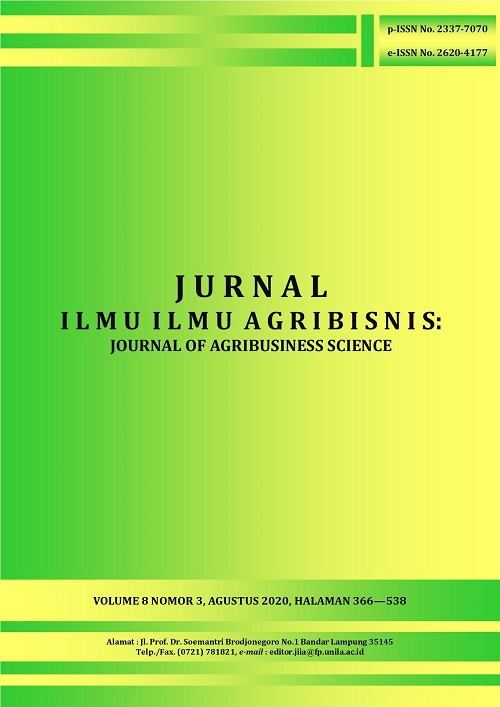POLA KONSUMSI DAN TINGKAT KETAHANAN PANGAN RUMAH TANGGA MISKIN DI KECAMATAN GADINGREJO KABUPATEN PRINGSEWU
DOI:
https://doi.org/10.23960/jiia.v8i3.4449 Abstract View: 427
Abstract View: 427
Abstract
This research aimed to analyze the food consumption pattern, the level of food security, and factors that affected the level of food security of poor households. The location was chosen purposively at Gadingrejo Subdistrict, Pringsewu Regency in which respondents were 61 poor households. The data of this research were primary data and secondary data collected in April – Mei 2018 and analyzed using statistic descriptive analysis, cross classification between the share of food expenditure and availability in addition to food sufficiency level, and ordinal logistic regression analysis. The results of this research showed that there were 14 types of food consumed by households per day, the household PPH score of Demapan Program members was 69.78 and nonmembers was 65.62. As many as 46.67 percent member households of Demapan Program and 35.48 percent nonmember households of the Program were classified as food secured. The factors affected the level of food security were household income, the number of household members, and price of the rice. There was no difference in the level of food security between member and nonmember households of Demapan Program.
Key words: consumption pattern, demapan program, food security
Downloads
Downloads
Published
How to Cite
Issue
Section
License
Authors who publish with this journal agree to the following terms:
Authors retain copyright and grant the journal right of first publication with the work simultaneously licensed under a Creative Commons Attribution License that allows others to share the work with an acknowledgement of the work's authorship and initial publication in this journal.
Authors are able to enter into separate, additional contractual arrangements for the non-exclusive distribution of the journal's published version of the work (e.g., post it to an institutional repository or publish it in a book), with an acknowledgement of its initial publication in this journal.
Authors are permitted and encouraged to post their work online (e.g., in institutional repositories or on their website) prior to and during the submission process, as it can lead to productive exchanges, as well as earlier and greater citation of published work (See The Effect of Open Access).














